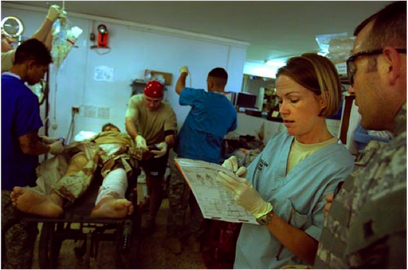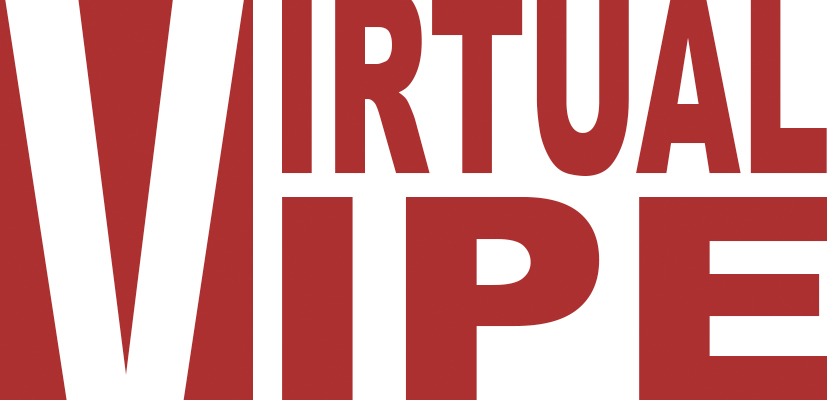 The CASH is a series of tents which make up a complete field hospital. Their primary clientele are US soldiers, but they also occasionally treat wounded enemy soldiers and civilians. There are usually 84 beds, but the CASH that Mr. Jones was evacuated to has 256 beds. They are climate controlled and usually include a pharmacy, lab and x-ray facilities (often including CT scan) and basic dental care. The Hospital Unit Surgical (HUS) is staffed by surgical personnel, including surgeons, surgical nurses, surgical technicians, nurse anesthetists and anesthesiologists. A fully manned CSH has 624 people to staff 256 beds. A Medical Evacuation Company, attached to the CASH, is responsible for evacuation of injured patients from forward units back to the CASH, and also for evacuation of injured patients from Afghanistan back to Germany or the continental US.
The CASH is a series of tents which make up a complete field hospital. Their primary clientele are US soldiers, but they also occasionally treat wounded enemy soldiers and civilians. There are usually 84 beds, but the CASH that Mr. Jones was evacuated to has 256 beds. They are climate controlled and usually include a pharmacy, lab and x-ray facilities (often including CT scan) and basic dental care. The Hospital Unit Surgical (HUS) is staffed by surgical personnel, including surgeons, surgical nurses, surgical technicians, nurse anesthetists and anesthesiologists. A fully manned CSH has 624 people to staff 256 beds. A Medical Evacuation Company, attached to the CASH, is responsible for evacuation of injured patients from forward units back to the CASH, and also for evacuation of injured patients from Afghanistan back to Germany or the continental US.
Case Notes
Medical & Physician Assistant
Admission Medical H&P
Combat Surgical Hospital, Afghanistan
Date: 4-19-2011
HPI : Patient presented to trauma bay with multiple blast injuries. Was embedded with local unit, on patrol in Humvee when IED (improvised explosive device) exploded near left front tire. Patient sustained blast injuries to left face and ear, left shoulder, left chest, left flank, and LLE (left lower extremity)
PMH: Medical records not initially available, patient unable to give detailed history prior to intubation.
Medications: none known
Allergies: NKDA (no known drug allergies)
Immunizations: Last Td (Tetanus-diptheria)> 5 years ago
Past Surgical Hx: Appendectomy age 12, SCC (squamous cell carcinoma) removed left cheek mole 2002, no sequellae.
Family Hx: unobtainable
Social Hx: Married, denies tobacco or illicit drug use, occasional ETOH (alcohol)
Religion: agnostic
PE:
Mental Status: Awake, alert, but not oriented. Confused and speaking in 1-2 word utterances. Follows verbal instructions inconsistently. Glasgow Coma Score of 10; no ISS (Injury Severity Score) or Apache Score was recorded.
Vitals Signs: Initially: Pulse 120, Respiration 24 labored, BP 90/75, Temp 99, Pulse oximetry: 91% on room air, 92% after intubation with FiO2=100%. After 2 liters RL: Pulse 106, Respiration 12 by vent, BP (blood pressure) 116/78.
HEENT: Contusions, superficial lacerations, and abrasions noted along the entire left side of his face and neck. Scant blood is seen in left external auditory meatus. No TM (tympanic membrane) is seen on the left; intact TM is seen and pearly gray on the right. No fluid from the right ear. No palpable skull defect; shrapnel in left temporal/parietal scalp/skin, but no obvious puncture into skull appreciated on initial palpation. No periorbital edema or bruising or bruising over the mastoids. PERRL (pupils equally round and reactive to light) at 4 mm each. Conjunctiva non-injected. Trachea midline without shift; thyroid without noted enlargement or nodularity; carotid upstrokes normal bilaterally without bruits, mandible swollen with no occlusion defect (no malocclusion). Tongue midline and dry. Cranial Nerves 2-12 reported grossly intact prior to intubation. CN 8 is incompletely assessed at this time as is CN 1. Cervical collar in place.
Chest: Lung sounds reveal crackles bilaterally, no tracheal shift. Symmetric chest movement but labored breathing prior to intubation. Minor lacerations and abrasions noted on the left chest wall. Left axillary adenopathy appreciated.
Cardiac: Tachycardic, no murmurs, no gallops. No muffling of heart sounds. No palpable thrills; PMI at left 5th left intercostal space
Abdomen: Multiple abrasions, contusions, and lacerations over left flank and left lower quadrant. Several minor abrasions and superficial lacerations over anterior left upper quadrant. Tender on left abdomen from abrasions; no rebound, no guarding—otherwise soft and non-distended.
Back: Patient is “log-rolled” holding c-spine in place; except for abrasions and contusions on the left-side/left flank (about 10% BSA-Body Surface Area), no obvious injury, malformation, or deformity of the back.
GU: Normal adult male; circumcised, testes palpable without masses; no blood at urethral meatus. Rectal exam reveals normal sphincter tone and is hemoccult negative, prostate 2+, symmetric, no nodules
LUE: No fractures, full PROM (passive range of motion), equal pulses, no edema. Moving spontaneously. Numerous abrasions over scapular area.
RUE: No fractures, full PROM, intact equal pulses, no edema. Spontaneous movement.
LLE: Open fracture of the mid-shaft of the femur. Distal pulses intact, symmetric at 2+/2+. DP/PT (dorsalis pedis/posterior tibialis) pulses bilaterally equal. Wound over open fracture site has some dirt and abrasions. About 1 cm of femur is extending through skin. Concern for fracture of patella. Left inguinal adenopathy appreciated. Plantar reflex downgoing.
RLE: No fractures, full PROM, intact equal pulses, no edema. Decreased spontaneous movement. Plantar reflex downgoing.
Impression: Penetrating trauma, blunt force trauma, possible Closed Head Injury (CHI), tachypnea, tachycardia, mild hypotension from blood loss, left TM rupture, left pinna tear/laceration, multiple contusions and minor lacerations/abrasions of left flank, left leg, left shoulder, left chest, and abdomen; contaminated, open femur fracture of left leg.
Plan:
1. Endotracheal intubation because of marked tachypnea and tachycardia, decreased GCS (Glasglow Coma Scale), and obvious head trauma. Induction via succinylcholine and etamidate (succinylcholine 100mg iv x1 plus etomidate 20 mg iv x1)
2. Two large bore intravenous lines were placed. 2 liters of lactated ringer’s solution wide open bolus; then 150 cc/hour. Switch to NS after the 2 liters.
3. Chest-x-ray in trauma room- no apparent pneumo/hemothorax or broken ribs; infiltrates noted in left lung fields.
4. C-spine x-ray shows no obvious fracture or dislocation.
5. Pelvis, left femur, left hip, left tibia/fibula radiologic films-comminuted mid-shaft femur fracture with 30 degree angulation and 100% displacement. Hip, pelvis, and tib/fib without obvious bony abnormalities
6. Tetanus toxoid
7. Ancef 1 gram IVPB in trauma bay
8. Induce coma with pentobarbital- titrate to LOC
9. Left Leg immobilization with traction splint; monitor pulse frequently
10. Continue C-collar and cervical spine precautions until neck is cleared with CT of neck
11. Ventilatory assistance, cardiac monitoring, pulse oximetry.
12. Foley catheter placement and care.
13. Monitor I and O
14. CBC and differential, Comprehensive/complete Metabolic Profile, arterial blood gas, PT/ PTT, Urine Analysis, Type and Cross 2 units packed red blood cells (prbc)
15. Place NG (nasogastric) tube
16. Clean abrasions with saline and peroxide, apply bacitracin and sterile dressings
17. Apply compression stockings
18. Fentanyl iv for pain control
19. PREPARE FOR TRANSPORT TO GERMANY
Osteopathic
Admission Osteopathic Palpatory Evaluation
Combat Surgical Hospital, Afghanistan
4-21-2011
This additional information was obtained after the initial medical history and physical and after the patient was stabilized. Limited evaluation.
Head:
Noted left facial and head trauma-open wounds, lacerations, and abrasions. Left occipital condylar compression. Limited evaluation due to trauma and intubation.
Cervical: restricted examination due to cervical collar and intubation.
Thorax: elevated left clavicle; inhalation restriction ribs 1-4 on the left; exhalation somatic dysfunction of the thoraco-abdominal diaphragm with restriction of ribs 6-8 on the right, 8-12 on the left, and inhalation somatic dysfunction ribs 10-12 on the right; nodularity 3 and 4 ics left; increased paravertebral muscle tone T1-6 bilaterally and T8-12 left greater than right.
Lumbar: limited evaluation-increased paravertebral muscle tone in the thoraco-lumbar region bilaterally; lumbo-sacral compression
Abdomen: noted abrasions, lacerations, and contusions on the left flank and side.
Sacrum: limited evaluation-sacral torsion
Pelvis: limited evaluation-posterior left innominate; positive left SI compression test; restricted pelvic diaphragm
Upper Extremities: limited evaluation-no fractures noted. Some lacerations, abrasions, and wounds on the left. Intravenous access bilaterally.
Lower Extremities: open left femoral fracture. Examination limited.
Impression: additionally see medical admission H and P for this facility
1. Multiple somatic dysfunctions of the head, cervical/thoracic/lumbar/ sacral spines, pelvis, abdomen, upper and lower extremities.
2. S/p head injury with temporal fracture on ventilator in a medically induced coma
3. Contaminated, open left femoral fracture
4. Pulmonary contusion left
5. Ruptured left tympanic membrane
Plan:
1. CV4 and limited OMT
2. Care per medical team
Nursing
SBAR Handoff Report-Nursing- Afghanistan to Germany
Date of Report: 4-21-11
Given by: F. Nightengale, BSN, RN
Jones, Charles Robert (Chip) MRN: 593231
Date: April 19, 2011
38 year old Male
Code status: Full Code
Allergies: NKA
Weight: 75kg/ 235lbs Height: 6’ / 72”
Admitting Diagnosis: Trauma
Brief History of hospital course: Riding in Humvee on photo shoot with military, struck by improvised explosive device (IED). Sustained serious injuries to left side of body including arm, leg, chest, and head/face.
Family/Social Concerns: Wife, Nancy and 3 children under 10 living in Tubac, Arizona
His parents live in Tucson, and wife’s parents live in Tubac. Patient is a photographer & videographer.
Clinical Assessment:
Body SystemNeuro: |
InterventionContinuous monitoring, Q2 hour & prn assessments per protocol. Propofol gtt continuous for sedation while on vent. BIS monitoring Sedation “vacation” q shift for neuro assessment. Morphine IV PRN |
ResponsePt resting quietly with eyes closed BIS 65-75 Follows commands intermittently Pt nods head that pain is minimal, VS WNL. No grimacing or restlessness |
| Respiratory: Upper R/L-clear/clear Lower R/L – crackles/crackles Lung expansion-symmetric Breathing pattern-symmetric Ventilator: Intubated with 8.5 ETT, 23cm @ lip Mode; SIMV FIO2: 60% Rate: 12, breathing 12-16 Tidal volume: 850 PEEP: 5 PS: 10 SaO2: 100% Sputum – Moderate, yellow |
Collaborate with RT for vent mgmt. per protocol, SVN’s as ordered
In-line suctioning PRN, titrate O2 to keep sats >92%, ABG’s q shift and prn. Continuous monitoring, Q2 hour & prn assessments per protocol. |
Regular, even respirations, ABG’s show resp alkalosis, SaO2 99% |
| Cardiac: Heart Rhythm: Sinus Tachycardia Heart Rate: 110-120 Cap Refill: <2 seconds Turgor: brisk Radial pulses 3+ bilaterally Femoral pulses 3+ bilaterally Popliteal pulses 2+ bilaterally Dorsalis pedis pulses 2+ bilaterally CVP- 6 C/O- 7 LPM |
Continuous monitoring, Q2 hour & prn assessments per protocol.
LR @ 150/hr. Hypotensive crisis management protocol. |
Vital signs stable. Hemodaynamic values WNL, assessment WNL. |
| GI/GU: Bowel Sounds: Normoactive x 4 Abdomen: Soft, not-tender Urine: Clear, yellow, 14 Fr. Foley in place Stool: Formed, hemoccult negative Drains: NGT to LIWS Diet: NPO Feedings: n/a |
Continuous monitoring, Q2 hour & prn assessments per protocol. Foley care BID, monitor u/o Q 1 hr Monitor NGT drainage Q 12 hours |
Formed stool x 1.
Urine drainage clear, yellow. NGT 75 mls dark green per shift |
| Integumentary Lips: moist, pink Mouth: moist, pink Color: light pink undertones Texture: Smooth Incisions/wounds: multiple abrasions, contusions, lacerations to left side of face, LL flank & LLQ, Open fracture LLE. Traction splint in place |
Sterile dressing changes with sodium chloride. Pin care BID. |
Dressing clean, dry and intact. Redness and warmth noted on LLE. |
| Lines: Peripheral: 18g RFA started 4/19 18G LAC started 4-19 Central: R SC TLC started 4/19 Arterial Line – R radial started 4/19 |
IV. Central line care per protocol. |
No redness, swelling or discharge noted. |
| Vitals: T 99.0 HR 110, BP 110/74, RR 16, SaO2 99%. BP and HR rise with stimulation |
VS Q 2 hours & prn per protocol | VS WNL |
